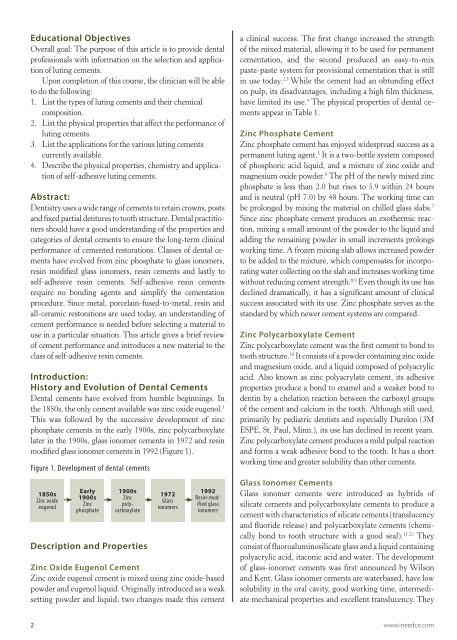A Practical Guide to the Use of Luting Cements - IneedCE.com
A Practical Guide to the Use of Luting Cements - IneedCE.com
A Practical Guide to the Use of Luting Cements - IneedCE.com
Create successful ePaper yourself
Turn your PDF publications into a flip-book with our unique Google optimized e-Paper software.
Educational Objectives<br />
Overall goal: The purpose <strong>of</strong> this article is <strong>to</strong> provide dental<br />
pr<strong>of</strong>essionals with information on <strong>the</strong> selection and application<br />
<strong>of</strong> luting cements.<br />
Upon <strong>com</strong>pletion <strong>of</strong> this course, <strong>the</strong> clinician will be able<br />
<strong>to</strong> do <strong>the</strong> following:<br />
1. List <strong>the</strong> types <strong>of</strong> luting cements and <strong>the</strong>ir chemical<br />
<strong>com</strong>position.<br />
2. List <strong>the</strong> physical properties that affect <strong>the</strong> performance <strong>of</strong><br />
luting cements.<br />
3. List <strong>the</strong> applications for <strong>the</strong> various luting cements<br />
currently available.<br />
4. Describe <strong>the</strong> physical properties, chemistry and application<br />
<strong>of</strong> self-adhesive luting cements.<br />
Abstract:<br />
Dentistry uses a wide range <strong>of</strong> cements <strong>to</strong> retain crowns, posts<br />
and fixed partial dentures <strong>to</strong> <strong>to</strong>oth structure. Dental practitioners<br />
should have a good understanding <strong>of</strong> <strong>the</strong> properties and<br />
categories <strong>of</strong> dental cements <strong>to</strong> ensure <strong>the</strong> long-term clinical<br />
performance <strong>of</strong> cemented res<strong>to</strong>rations. Classes <strong>of</strong> dental cements<br />
have evolved from zinc phosphate <strong>to</strong> glass ionomers,<br />
resin modified glass ionomers, resin cements and lastly <strong>to</strong><br />
self-adhesive resin cements. Self-adhesive resin cements<br />
require no bonding agents and simplify <strong>the</strong> cementation<br />
procedure. Since metal, porcelain-fused-<strong>to</strong>-metal, resin and<br />
all-ceramic res<strong>to</strong>rations are used <strong>to</strong>day, an understanding <strong>of</strong><br />
cement performance is needed before selecting a material <strong>to</strong><br />
use in a particular situation. This article gives a brief review<br />
<strong>of</strong> cement performance and introduces a new material <strong>to</strong> <strong>the</strong><br />
class <strong>of</strong> self-adhesive resin cements.<br />
Introduction:<br />
His<strong>to</strong>ry and Evolution <strong>of</strong> Dental <strong>Cements</strong><br />
Dental cements have evolved from humble beginnings. In<br />
<strong>the</strong> 1850s, <strong>the</strong> only cement available was zinc oxide eugenol. 1<br />
This was followed by <strong>the</strong> successive development <strong>of</strong> zinc<br />
phosphate cements in <strong>the</strong> early 1900s, zinc polycarboxylate<br />
later in <strong>the</strong> 1900s, glass ionomer cements in 1972 and resin<br />
modified glass ionomer cements in 1992 (Figure 1).<br />
Figure 1. Development <strong>of</strong> dental cements<br />
1850s<br />
Zinc oxide<br />
eugenol<br />
Early<br />
1900s<br />
Zinc<br />
phosphate<br />
1900s<br />
Zinc<br />
polycarboxylate<br />
Description and Properties<br />
1972<br />
Glass<br />
ionomers<br />
1992<br />
Resin-modified<br />
glass<br />
ionomers<br />
Zinc Oxide Eugenol Cement<br />
Zinc oxide eugenol cement is mixed using zinc oxide-based<br />
powder and eugenol liquid. Originally introduced as a weak<br />
setting powder and liquid, two changes made this cement<br />
a clinical success. The first change increased <strong>the</strong> strength<br />
<strong>of</strong> <strong>the</strong> mixed material, allowing it <strong>to</strong> be used for permanent<br />
cementation, and <strong>the</strong> second produced an easy-<strong>to</strong>-mix<br />
paste-paste system for provisional cementation that is still<br />
in use <strong>to</strong>day. 2,3 While <strong>the</strong> cement had an obtunding effect<br />
on pulp, its disadvantages, including a high film thickness,<br />
have limited its use. 4 The physical properties <strong>of</strong> dental cements<br />
appear in Table 1.<br />
Zinc Phosphate Cement<br />
Zinc phosphate cement has enjoyed widespread success as a<br />
permanent luting agent. 5 It is a two-bottle system <strong>com</strong>posed<br />
<strong>of</strong> phosphoric acid liquid, and a mixture <strong>of</strong> zinc oxide and<br />
magnesium oxide powder. 6 The pH <strong>of</strong> <strong>the</strong> newly mixed zinc<br />
phosphate is less than 2.0 but rises <strong>to</strong> 5.9 within 24 hours<br />
and is neutral (pH 7.0) by 48 hours. The working time can<br />
be prolonged by mixing <strong>the</strong> material on chilled glass slabs. 7<br />
Since zinc phosphate cement produces an exo<strong>the</strong>rmic reaction,<br />
mixing a small amount <strong>of</strong> <strong>the</strong> powder <strong>to</strong> <strong>the</strong> liquid and<br />
adding <strong>the</strong> remaining powder in small increments prolongs<br />
working time. A frozen mixing slab allows increased powder<br />
<strong>to</strong> be added <strong>to</strong> <strong>the</strong> mixture, which <strong>com</strong>pensates for incorporating<br />
water collecting on <strong>the</strong> slab and increases working time<br />
without reducing cement strength. 8,9 Even though its use has<br />
declined dramatically, it has a significant amount <strong>of</strong> clinical<br />
success associated with its use. Zinc phosphate serves as <strong>the</strong><br />
standard by which newer cement systems are <strong>com</strong>pared.<br />
Zinc Polycarboxylate Cement<br />
Zinc polycarboxylate cement was <strong>the</strong> first cement <strong>to</strong> bond <strong>to</strong><br />
<strong>to</strong>oth structure. 10 It consists <strong>of</strong> a powder containing zinc oxide<br />
and magnesium oxide, and a liquid <strong>com</strong>posed <strong>of</strong> polyacrylic<br />
acid. Also known as zinc polyacrylate cement, its adhesive<br />
properties produce a bond <strong>to</strong> enamel and a weaker bond <strong>to</strong><br />
dentin by a chelation reaction between <strong>the</strong> carboxyl groups<br />
<strong>of</strong> <strong>the</strong> cement and calcium in <strong>the</strong> <strong>to</strong>oth. Although still used,<br />
primarily by pediatric dentists and especially Durelon (3M<br />
ESPE, St. Paul, Minn.), its use has declined in recent years.<br />
Zinc polycarboxylate cement produces a mild pulpal reaction<br />
and forms a weak adhesive bond <strong>to</strong> <strong>the</strong> <strong>to</strong>oth. It has a short<br />
working time and greater solubility than o<strong>the</strong>r cements.<br />
Glass Ionomer <strong>Cements</strong><br />
Glass ionomer cements were introduced as hybrids <strong>of</strong><br />
silicate cements and polycarboxylate cements <strong>to</strong> produce a<br />
cement with characteristics <strong>of</strong> silicate cements (translucency<br />
and fluoride release) and polycarboxylate cements (chemically<br />
bond <strong>to</strong> <strong>to</strong>oth structure with a good seal). 11,12 They<br />
consist <strong>of</strong> fluoroaluminosilicate glass and a liquid containing<br />
polyacrylic acid, itaconic acid and water. The development<br />
<strong>of</strong> glass-ionomer cements was first announced by Wilson<br />
and Kent. Glass ionomer cements are waterbased, have low<br />
solubility in <strong>the</strong> oral cavity, good working time, intermediate<br />
mechanical properties and excellent translucency. They<br />
2 www.ineedce.<strong>com</strong>
















